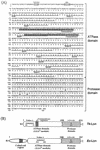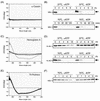A membrane-bound archaeal Lon protease displays ATP-independent proteolytic activity towards unfolded proteins and ATP-dependent activity for folded proteins
- PMID: 12057965
- PMCID: PMC135145
- DOI: 10.1128/JB.184.13.3689-3698.2002
A membrane-bound archaeal Lon protease displays ATP-independent proteolytic activity towards unfolded proteins and ATP-dependent activity for folded proteins
Abstract
In contrast to the eucaryal 26S proteasome and the bacterial ATP-dependent proteases, little is known about the energy-dependent proteolysis in members of the third domain, Archae. We cloned a gene homologous to ATP-dependent Lon protease from a hyperthermophilic archaeon and observed the unique properties of the archaeal Lon. Lon from Thermococcus kodakaraensis KOD1 (Lon(Tk)) is a 70-kDa protein with an N-terminal ATPase domain belonging to the AAA(+) superfamily and a C-terminal protease domain including a putative catalytic triad. Interestingly, a secondary structure prediction suggested the presence of two transmembrane helices within the ATPase domain and Western blot analysis using specific antiserum against the recombinant protein clearly indicated that Lon(Tk) was actually a membrane-bound protein. The recombinant Lon(Tk) possessed thermostable ATPase activity and peptide cleavage activity toward fluorogenic peptides with optimum temperatures of 95 and 70 degrees C, respectively. Unlike the enzyme from Escherichia coli, we found that Lon(Tk) showed higher peptide cleavage activity in the absence of ATP than it did in the presence of ATP. When three kinds of proteins with different thermostabilities were examined as substrates, it was found that Lon(Tk) required ATP for degradation of folded proteins, probably due to a chaperone-like function of the ATPase domain, along with ATP hydrolysis. In contrast, Lon(Tk) degraded unfolded proteins in an ATP-independent manner, suggesting a mode of action in Lon(Tk) different from that of its bacterial counterpart.
Figures






References
-
- Akiyama, Y., A. Kihara, H. Tokuda, and K. Ito. 1996. FtsH (HflB) is an ATP-dependent protease selectively acting on SecY and some other membrane proteins. J. Biol. Chem. 271:31196-31201. - PubMed
-
- Amerik, A., V. K. Antonov, A. E. Gorbalenya, S. A. Kotova, T. V. Rotanova, and E. V. Shimbarevich. 1991. Site-directed mutagenesis of La protease. A catalytically active serine residue. FEBS Lett. 287:211-214. - PubMed
-
- Black, M. J., and M. E. Jones. 1983. Inorganic phosphate determination in the presence of a labile organic phosphate: assay for carbamyl phosphate phosphatase activity. Anal. Biochem. 135:233-238. - PubMed
-
- Bochtler, M., C. Hartmann, H. K. Song, G. P. Bourenkov, H. D. Bartunik, and R. Huber. 2000. The structures of HsIU and the ATP-dependent protease HsIU-HsIV. Nature 403:800-805. - PubMed
-
- Bradford, M. M. 1976. A rapid and sensitive method for the quantitation of microgram quantities of protein utilizing the principle of protein-dye binding. Anal. Biochem. 72:248-254. - PubMed
MeSH terms
Substances
Associated data
- Actions
LinkOut - more resources
Full Text Sources
Other Literature Sources

